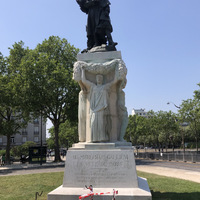How to cite this page Comment citer cette page
2020, Critical social media posts about the monument to Gallieni in Paris
Event
- has description | a une description
-
Following the murder of George Floyd by a police officer in the United States, antiracist protests inspired by Black Lives Matter flourished in France in the Spring of 2020.
On June 10, the popular content creator behind Histoires Crêpues, a YouTube channel, Instagram and Twitter account, shared a 4 minutes Instagram video in front of Gallieni's statue. He reposted various versions of it on Twitter and YouTube in the following days.
He mentioned that on June 7, antiracist protesters took down the statue of Edward Colston, and pointed out that in France also, the streets were full of homages to colonizers and slave traders.
He gave historical context on Gallieni's colonial career, his invading the then called French Sudan, in Tonkin (Vietnam), and sent to quash resisting forces in Madagascar. He linked sources to Gallieni's writings, including a passage of Gallieni's Rapport d'ensemble sur la pacification, l'organisation et la colonisation de Madagascar, where Gallieni talks about "la politique des races", a military occupation strategy where France would pit Madagascar's different ethnicities against one another, focusing on destroying the ethnic group that was the most hostile to French colonialism.
The content creator argued that Gallieni was in that sense relying on Arthur de Gobineau's racist theories. While racist ideologies underpinned the entire French colonial project, with the idea that France was superior to the populations it invaded and submitted to its rule, Gallieni's doctrine required to study local power dynamics and the cultural specificities of each ethnic group to France's advantage.
He asked why Gallieni had so much presence in French public space, citing a métro station, and the avenue Gallieni in Paris, a prestigious street that connects the Seine to the Invalides building, deploring that it was dedicated to the colonial hero who designed "la politique des races". He deplored that not knowing this history was making it more difficult to combat racism in contemporary France. (From the video: "elle est consacrée au héros colonial concepteur de la politique des races. C'est à peine croyable, comment peut-on espérer lutter contre lutter contre le racisme en France quand personne ne connaît cette histoire ?")
He then goes around the monument and describes its component, insisting on the allegories of the pedestal, point out that they are "clichés" linked to Gallieni's colonial career and that the Africa woman is bare-chested. He also points out that the monument was commissioned by the Ligue Maritime et Coloniale Française, reading the inscription on the plinth. "Ce sont ces quatre personnages qui représentent les peuples qui ont été colonisés par Gallieni et qui le portent. Franchement, c'est extrême. Franchement, je sais pas, en tant qu'afrodescendant, tu te balades dans la rue, et tu vois ce genre de monuments en l'honneur d'un héros colonial, ça fait mal en fait, c'est... franchement, je sais même pas quoi dire."
He ends this video asking whether these public homages are still necessary, or if more context would be needed to fully understand the history alluded to by the monument, suggesting that it might be better to place it in a museum. Finally, he asked municipal and state power what the message was to the population, by keeping these colonial monuments without explanation, and urged for more education about history of French colonialism and slavery to combat racism today.
"Est-ce que nous avons vraiment besoin de tous ces hommages coloniaux ? Ne seraient-ils pas mieux dans des musées qui pourraient clairement nous expliquer cette histoire ? Je m'adresse directement à la mairie du 7e arrondissement de Paris, au Ministère de la Culture, et à Emmanuel Macron, président de la République française. Je demande : quel est le message que vous voulez nous faire passer en conservant ces hommages coloniaux sans nous donner aucun contexte historique pour mieux les comprendre ? On veut des réponses. Je crois que continuer à creuser notre histoire coloniale c'est un bon moyen de lutter contre le racisme tel qu'il existe aujourd'hui dans notre pays la France. Un racisme directement lié à notre histoire coloniale et notre passé esclavagiste français."
In the following days, comments and reposts on social media engage with the contents of the video about the monument, both critical of Gallieni, and critical of Histoires Crêpues. - has type | est de type
- contestation
- carried out by | réalisée par
- Histoires Crêpues (YouTube and Intagram channel)
- took place on or within | a eu lieu le ou dans l'intervalle de temps
- 10 June 2020
- was motivated by | le déplacement a été motivé par
-
 Black Lives Matter (BLM)
Black Lives Matter (BLM)
